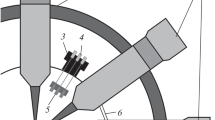Abstract
Three mathematical models for the thermal damage of semiconductor structures with a single junction (diodes, FETs, single-heterojunction bipolar transistors, and photodiodes) are characterized. Similarly to the Wunsch-Bell model, the proposed models are based on solutions to the 1D heat equation. In contrast to the Wunsch-Bell model, in which the thickness of the junction is assumed infinite and a rectangular acting pulse has an infinitely short leading edge, the proposed models take into account the finite dimensions of the junction; the pulse shape; and the pulse-leading-edge steepness, which is important for any mechanism of the functional damage. Conditions for the applicability of each model for the estimation of the criterial levels of functional damage in semiconductor structures are determined. It is emphasized that the heat equation should be solved with allowance for matched initial and boundary conditions.
Similar content being viewed by others
References
D. Wunsch and R. Bell, IEEE Trans. Nucl. Sci. 15, 244 (1968).
L. W. Ricketts, J. E. Bridges, and J. Miletta, EMP Radiation and Protective Techniques (Wiley, New York, 1976; Atomizdat, Moscow, 1979).
H. S. Carslaw and J. C. Jaeger, Conduction of Heat in Solids, 2nd ed. (Clarendon, Oxford, 1959; Nauka, Moscow, 1964).
D. M. Taska, IEEE Trans. Nucl. Sci. 17, 364 (1970).
V. V. Antipin, V. A. Godovitsyn, D. V. Gromov, et al., “Effect of High-Power Microwave Pulse Interferences on Semiconductor Devices and Integrated Chips,” Zarubezh. Radioelektron., No. 1, 37 (1995).
V. D. Dobykin, Radiotekh. Elektron. (Moscow) 45, 367 (2000) [J. Commun. Technol. Electron. 45, 339 (2000)].
V. D. Dobykin, Radiotekh. Elektron. (Moscow) 49, 365 (2004) [J. Commun. Technol. Electron. 49, 338 (2004)].
V. D. Dobykin and V. V. Kharchenko, Radiotekh. Elektron. (Moscow) 51, 242 (2006) [J. Commun. Technol. Electron. 51, 231 (2006)].
A. N. Tikhonov and A. A. Samarskii, Equations of Mathematical Physics (Nauka, Moscow, 1996; Pergamon, Oxford, 1964).
Additional information
Original Russian Text © V.D. Dobykin, 2008, published in Radiotekhnika i Elektronika, 2008, Vol. 53, No. 1, pp. 108–111.
Rights and permissions
About this article
Cite this article
Dobykin, V.D. Development of the theory for thermal damage of semiconductor structures by high-power electromagnetic radiation. J. Commun. Technol. Electron. 53, 100–103 (2008). https://doi.org/10.1134/S1064226908010129
Received:
Published:
Issue Date:
DOI: https://doi.org/10.1134/S1064226908010129



